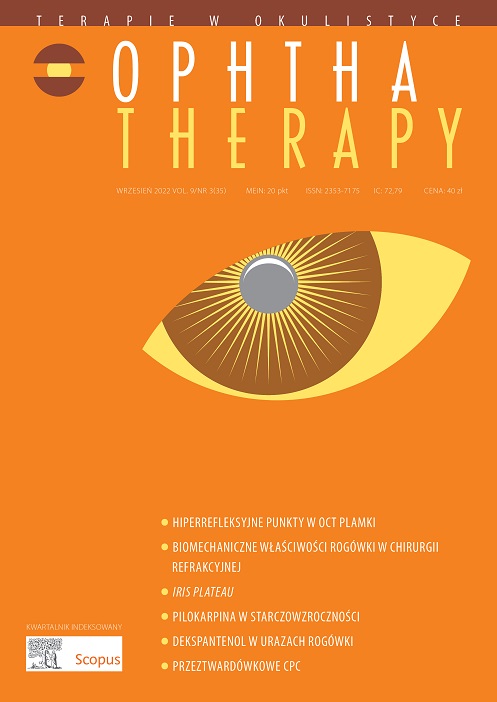Dexpanthenol in the treatment of corneal disorders and injuries Review article
Main Article Content
Abstract
Dexpanthenol – a precursor to vitamin B5 – is a compound of natural origin that has a long-known beneficial effect on skin and mucous membrane hydration and epithelial healing. Its anti-inflammatory activity is also used in treatment. Its effects on superficial tissues have been observed in numerous in vitro and in vivo studies, but the exact mechanism of action has not yet been understood. In ophthalmology, dexpanthenol is a well-known and widely used drug in patients with acute and chronic diseases of the ocular surface, as well as for treating the sequelae of corneal injuries.
Downloads
Article Details
Copyright: © Medical Education sp. z o.o. License allowing third parties to copy and redistribute the material in any medium or format and to remix, transform, and build upon the material, provided the original work is properly cited and states its license.
Address reprint requests to: Medical Education, Marcin Kuźma (marcin.kuzma@mededu.pl)
References
2. Hamdi IM. Effect of D-Panthenol on Corneal Epithelial Healing after Surface Laser Ablation. J Ophthalmol. 2018; 2018: 6537413.
3. Nagar A, Jain S, Singh S. Brief Communication: Dexpanthenol and Its Ophthalmic Uses. J Clin Exp Ophthalmol. 2017; 8: 5.
4. Cho YS, Kim HO, Woo SM et al. Use of Dexpanthenol for Atopic Dermatitis – Benefits and Recommendations Based on Current Evidence. J Clin Med. 2022; 11(14): 3943.
5. Novelli GD. Metabolic functions of pantothenic acid. Physiol Rev. 1953; 33(4): 525-43.
6. Proksch E, de Bony R, Trapp S et al. Topical use of dexpanthenol: a 70th anniversary article. J Dermatolog Treat. 2017; 28(8): 766-73.
7. Forouzesh A, Forouzesh F, Samadi Foroushani S et al. A new method for calculating pantothenic acid content and determining appropriate pantothenic acid levels in foods. SSRN 2022: 4133416.
8. Ebner F, Heller A, Rippke F et al. Topical use of dexpanthenol in skin disorders. Am J Clin Dermatol. 2002; 3(6): 427-33.
9. Wiederholt T, Heise R, Skazik C et al. Calcium pantothenate modulates gene expression in proliferating human dermal fibroblasts. Exp Dermatol. 2009; 18: 969-78. http://doi.org/10.1111/j.1600-0625.2009.00884.x.
10. Gehring W, Gloor M. Effect of topically applied dexpanthenol on epidermal barrier function and stratum corneum hydration: Results of a human in vivo. Arzneimittel-Forschung. 2000; 50: 659-63.
11. Biro K, Thaçi D, Ochsendorf FR et al. Efficacy of dexpanthenol in skin protection against irritation: a double-blind, placebo-controlled study. Contact Dermatitis. 2003; 49(2): 80-4.
12. Abdelatif M, Yakoot M, Etmaan M. Safety and efficacy of a new honey ointment on diabetic foot ulcers: a prospective pilot study. J Wound Care. 2008; 17(3): 108-10.
13. Brzheskiy VV, Popov VY, Kalinina NM et al. [Prevention and treatment of degenerative changes in ocular surface epithelium in patients with dry eye syndrome]. Vestn Oftalmol. 2018; 134(5): 126-34.
14. Raczyńska K, Iwaszkiewicz-Bilikiewicz B, Stozkowska W et al. [Clinical evaluation of provitamin B5 drops and gel for postoperative treatment of corneal and conjuctival injuries]. Klin Oczna. 2003; 105(3-4): 175-8.
15. Egorov EA, Kalinin NI, Kiiasov AP. [New stimulants of corneal reparative regeneration]. Vestn Oftalmol. 1999; 115(6): 13-5.
16. Rüther L, Voss W. Hydrogel or ointment? Comparison of five different galenics regarding tissue breathability and transepidermal water loss. Heliyon. 2021; 7(1): e06071.
17. Dekspantenol. Opis.

